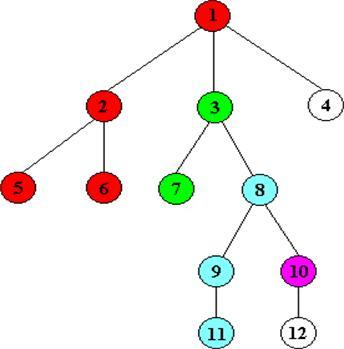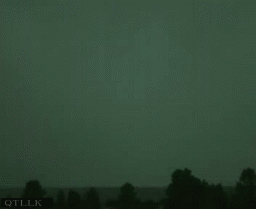dfs and bfs
https://www.cnblogs.com/wzl19981116/p/9397203.html
1.dfs (depth-first search) is in the first two search to understand and use, in fact, all the violence out of search paths, it uses backtracking to save this location, in-depth search, the search is over they are back back , search the next position, the deepest position until all are found again, the point to note is that there is time to search through the records of the location, you may want to change it back after the mark;
Backtracking is a search method, search forward under the conditions to meet the targets. But when a step to explore, discover previously selected to meet its target, it is a step back to re-select, this dead end on the return walk of technology backtracking; 
for example, this chart, starting from 1 to 2, then to 5 5 can not walk, and to return 2, 6, 2 return 1 return, to 3, has been carried out;
This method is relatively simple to understand, how difficult is to use
void dfs(int deep) { int x=deep/n,y=deep%n; if(符合某种要求||已经不能在搜了) { 做一些操作; return ; } if(符合某种条件且有地方可以继续搜索的)//这里可能会有多种条件,可能要循环什么的 { a[x][y]='x';//可能要改变条件,这个是瞎写的 dfs(deep+1,sum+1);//搜索下一层 a[x][y]='.';//可能要改回条件,有些可能不用改比如搜地图上有多少块连续的东西 } }2.bfs (width / breadth-first search), this idea has been understood, not use, will be back, thinking, beginning from a certain point, all sides can go the way to go, and then from the road, you can go looking for road, until the first to find qualified, need to use this application queue (queue), need to master this with a little bfs.

A map, bfs, and it is similar, good help understand mine from the top down, and to extend in all directions (of course, not very strict), and then find the nearest building, and then split it; 
or is this FIG Zhang, from 1 starts the search, there are several points 2,3,4, save it, starting from 2 5,6, save it, search 3, 7, 8, save up search 4, no; now just stored search start point, starting at 5, there is no, then the search 6 .. . It continues until found;
int visit[N][N]//用来记录走过的位置
int dir[4][2]={0,-1,0,1,-1,0,1,0}; struct node { int x,y,bits;//一般是点,还有步数,也可以存其他的 }; queue<node>v; void bfs1(node p) { node t,tt; v.push(p); while(!v.empty()) { t=v.front();//取出最前面的 v.pop();//删除 if(找到符合条件的) { 做记录; while(!v.empty()) v.pop();//如果后面还需要用,随手清空队列 return; } visit[t.x][t.y]=1;//走过的进行标记,以免重复 rep(i,0,4)//做多次查找 { tt=t; tt.x+=dir[i][0];tt.y+=dir[i][1];//这里的例子是向上下左右查找的 if(如果这个位置符合条件) { tt.bits++;//步数加一 v.push(tt); //把它推入队列,在后面的时候就可以用了 } } } }The difference 3.dfs and bfs
In fact, sometimes two can be used, but what other things need to be recorded, each with their own strengths
bfs是用来搜索最短径路的解是比较合适的,比如求最少步数的解,最少交换次数的解,因为bfs搜索过程中遇到的解一定是离最初位置最近的,所以遇到一个解,一定就是最优解,此时搜索算法可以终止,而如果用dfs,会搜一些其他的位置,需要搜很多次,然后还要一个东西来记录这次找的位置,之后找到的还要和这次找到的进行比较,这样就比较麻烦
dfs合搜索全部的解,因为要搜索全部的解,在记录路径的时候也会简单一点,而bfs搜索过程中,遇到离根最近的解,并没有什么用,也必须遍历完整棵搜索树。
bfs是浪费空间节省时间,dfs是浪费时间节省空间。因为dfs要走很多的路径,可能都是没用的,(做有些题目的时候要进行剪枝,就是确定不符合条件的就可以结束,以免浪费时间,否则有些题目会TLE);而bfs可以走的点要存起来,需要队列,因此需要空间来储存,但是快一点。
稍微理解之后就可以了,不一定要纠结怎么用,先去做题目,很多都是做着就突然明白怎么用了。
1.dfs(深度优先搜索)是两个搜索中先理解并使用的,其实就是暴力把所有的路径都搜索出来,它运用了回溯,保存这次的位置,深入搜索,都搜索完了便回溯回来,搜下一个位置,直到把所有最深位置都搜一遍,要注意的一点是,搜索的时候有记录走过的位置,标记完后可能要改回来;
回溯法是一种搜索法,按条件向前搜索,以达到目标。但当探索到某一步时,发现原先选择达不到目标,就退回一步重新选择,这种走不通就退回再走的技术为回溯法;
例如这张图,从1开始到2,之后到5,5不能再走了,退回2,到6,退回2退回1,到3,一直进行;
理解这种方法比较简单,难的是要怎么用
void dfs(int deep) { int x=deep/n,y=deep%n; if(符合某种要求||已经不能在搜了) { 做一些操作; return ; } if(符合某种条件且有地方可以继续搜索的)//这里可能会有多种条件,可能要循环什么的 { a[x][y]='x';//可能要改变条件,这个是瞎写的 dfs(deep+1,sum+1);//搜索下一层 a[x][y]='.';//可能要改回条件,有些可能不用改比如搜地图上有多少块连续的东西 } }2.bfs(宽度/广度优先搜索),这个一直理解了思想,不会用,后面才会的,思想,从某点开始,走四面可以走的路,然后在从这些路,在找可以走的路,直到最先找到符合条件的,这个运用需要用到队列(queue),需要稍微掌握这个才能用bfs。

一张图,bfs就是和它类似,很好的帮助理解,雷从上往下,同时向四面八方的延长(当然不是很严谨的),然后找到那个最近的建筑物,然后劈了它;
还是这张图,从1开始搜,有2,3,4几个点,存起来,从2开始有5,6,存起来,搜3,有7,8,存起来,搜4,没有了;现在开始搜刚刚存的点,从5开始,没有,然后搜6.。。一直进行,直到找到;
int visit[N][N]//用来记录走过的位置
int dir[4][2]={0,-1,0,1,-1,0,1,0}; struct node { int x,y,bits;//一般是点,还有步数,也可以存其他的 }; queue<node>v; void bfs1(node p) { node t,tt; v.push(p); while(!v.empty()) { t=v.front();//取出最前面的 v.pop();//删除 if(找到符合条件的) { 做记录; while(!v.empty()) v.pop();//如果后面还需要用,随手清空队列 return; } visit[t.x][t.y]=1;//走过的进行标记,以免重复 rep(i,0,4)//做多次查找 { tt=t; tt.x+=dir[i][0];tt.y+=dir[i][1];//这里的例子是向上下左右查找的 if(如果这个位置符合条件) { tt.bits++;//步数加一 v.push(tt); //把它推入队列,在后面的时候就可以用了 } } } }